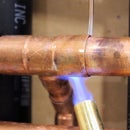Introduction: How to CORRECTLY Solder a Copper Pipe
Hi in this article I’ll be thoroughly explaining how to solder copper pipe to get a nice leak-free joint. If you’re unfamiliar with soldering, you’ll be able to solder any diameter pipe after this video with ease and peace of mind.
Step 1:
Step 2: TOOLS/MATERIALS FOR THE PROJECT
Alright, so the first things I wanna go thru are the tools and materials you’ll be needing to complete the task. So tool #1 is a torch. You’ll find a good torch at your local hardware store that should cost you between 20$ to 50$ Canadian dollars, Yes there are better models out there for commercial plumbers but if you are a DIYer doing minor work, these will do just fine.
To be able to use your new torch you’ll be needing some fuel. There are 2 varieties of fuels for you to choose from, you’ve got your ordinary “propane” gas which you can either find in the camping ile or in the plumbing section of the store or MAPP gas. The difference between both of these is that MAPP gas burns hotter than propane, which in turn heats up your joint quicker, so it’s up to you to choose which one you want to use.
You'll also need a lighter for your torch, If your torch doesn’t have one built-in, you can use a dedicated striker.
Something else you'll need is some flux. The primary purpose of flux is to prevent oxidation of the base and filler material when soldering.
Finally, you'll need some wire brushes, sandpaper, and solder. The plumbing code specifies to NOT use 50/50 solder as it contains lead, so use 95/5 or any solder that is lead-free.
Step 3: CLEANING THE PIPE & FITTING
Preparation is key to having a good leak-free joint. The first step to accomplish this is to clean both parts that’ll be joined together. To clean the pipe, take your sand paper and sand the portion that’ll penetrate the fitting until it resembles this. As you could see, there are no more surface spottings and that’s exactly what we are looking for. Next is the fitting. You’ll wanna use a dedicated size brush for your fitting to get it cleaned, they most often arrive clean from the manufacture but it’s important to get the surface roughed up a bit just so the solder can adhere better.
Step 4: FLUXING THE PIPE & FITTING
With both your surfaces now prepped, let’s assemble them, but before you’ll need to apply some flux. Applying the flux is pretty self-explanatory, all that’s needed is enough of it to cover both surfaces that touch just like in the picture.
Step 5: SOLDERING
With your flux now applied it’s time for the actual soldering process which is step 2. Now the goal here is to heat the portion you want your filler material to be pulled into. There’s a term for this and it’s called capillary action. Capillary action is the ability of a liquid (solder in this case) to flow in narrow spaces without the assistance of external forces, meaning it’ll flow upwards which is pretty cool.
It’s imperative to start heating your joint at the bottom FIRST, reason being is if you start heating the top first, your solder will want to flow down due to gravity but won’t have anywhere to go since the bottom of the joint is too cool to melt the solder, so always start from the bottom and work your way up.
So keep heating it up while testing your solder every now and then to see if it gets sucked in. Eventually, your joint will be hot enough to accept your solder so go ahead and run a nice bead all around the joint to ensure full coverage. A good tip here is to always inspect your joint after soldering it, it’ll speak for itself meaning that if you haven’t correctly heated the joint, you should see some voids in the joint. If this happens all you have to do is reapply a bit of flux, heat up the joint and solder the affected area.
Step 6: WIPE THE JOINT
As the final step, when you’re sure that your joint is soldered correctly, wait a couple of minutes for it to cool down. Some plumbers will use some flux to clean off the joint while it’s still very hot but doing this will cause a big drop in temperature in a very small amount of time and can fracture the joint causing a leak. Once your solder has solidified, use a rag to wipe off any excess flux that could potentially eat up your pipe in the long run, and you’re done.

Runner Up in the
Water Contest













